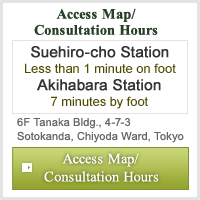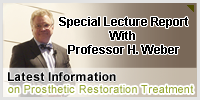2009年4月 5日 - 2009年4月11日 « トップへ » 2009年4月19日 - 2009年4月25日
2009年4月18日
Locking partial dentures [Riegel telescope]
Riegel is German for 'bolt' (as in a deadbolt). Riegel telescope dentures use a bolt-like locking mechanism as retention equipment.

There is a small lock on the inside of the dentures. When the lock is shut, it is nearly unnoticeable to the tongue. Dentures can be removed easily by simply opening the lock (it is opened easily by hand).
As opposed to Konus telescope, which are retained in the mouth by the wedging power of inner and outer crowns, Riegel telescope does not exert any force on existing crowns. Also, these dentures are well-suited for teeth that are missing nerves.
Comfort that will have you forgetting that you are wearing dentures
For the most part, our dentures are so comfortable that you will forget that you are even wearing them. You can brush your teeth before you go to bed, wash your dentures, and go to bed with them still in (there is no need to worry about swallowing them while you sleep).
Only your pearly whites are visible when you smile
Where Konus telescope inner crowns are scattered about, Riegel telescope inner crowns are linked and fixed together in place. The locking mechanism is placed where no one can see it making these dentures more esthetically pleasing than those covered by health insurance. When you smile, the only thing that people will be able to see are your beautiful pearly whites!
There are many types of telescope systems in Germany, but in Japan, Konus telescope is the only one that was known.
Some types of telescope system treatment methods are Parallel telescope, Konus telescope, Riegel telescope, and Resilience telescope. Certain types are best suited to treat certain cases.
Riegel telescope is one of these methods. The first time that our advisor, Dr. Inaba, saw Riegel telescope was during his stay at Tubingen University as a visiting professor in 1978. It was a telescope method that he had not yet seen during his clinical experience.
He was determined to learn this new method in Germany and was able to treat his first patients there. While under the instruction of Professor Koerber at Tubingen University, he was able to learn the manufacturing process by observing in detail the superior work of the Master Dental Technician, Schiever.
At first glance, Dr. Inaba thought that Riegel telescope resembled a retention device that could be used as a type of detachable bridge, but he had no idea how it was made. So Dr. Inaba was allowed to carry out clinical care on patents while learning the manufacturing process from the Master. At first he had no idea how the manufacturing process worked, but he began to understand gradually as if a magic trick was being revealed to him.
He learned that Professor Strack from Tubingen University was the brainchild of Riegel telescope, and that the first people to actually make these dentures were Master Oigen Shraihi, and Professor Koerber.
Revolving Riegel (Dreh Riegel) and Swing Riegel (Schwenk Riegel) are two kinds of Riegel telescope. The manufacturing process of Revolving Riegel is quite difficult and so it is not used so often these days. Riegel lever equipment features a nook that is very narrow which makes it very convenient to use.
The 'main feature' of Riegel telescope is that retention is not dependent on inner and outer crowns, which means that they are much easier to remove. Also, retention force fixes inner and outer crowns in place through the Riegel lever (the bolt). Once the lever is released there is no resistance, making attachment and detachment easy. The 'secondary feature' of Riegel telescope is that since the device is primarily fixed into place, abutment teeth are also fixed into place. With abutment teeth fixed into place, the dentures can be used as a long-term prosthetic. Dr. Inaba has seen a number of patients who have been using the same set of dentures for more than 30 years.
In recent years this method has even been used in the upper structure of implants. The technology is becoming more compatible with CAD/CAM and these dentures are becoming more adaptable as removable upper structures.
Konus telescope
Konus means 'cylindrical' in German and dentures made through this method consist of inner crowns that attach directly to the teeth, the denture body, and outer crowns (a dual crown system).
The inner crowns are cylindrical and have a 6 degree angle (the Konus angle). Retentive force is provided by the wedging force created between the inner and outer crowns. It may be easier to understand if you can imagine two cups of the same shape stacked over each other. The dentures make a snapping sound when they are shut and they will not come off.
There is a notch in the dentures where the patient places their finger and lifts to remove them. The angle of the crowns can be adjusted to fit the condition of the teeth.
Konus telescope dentures are not suitable for teeth that lack nerves. There may also be contraindication in places where teeth remain.
Differences between health insurance-covered dentures and dentures made using the maxillomandibular simultaneous impression method
Full dentures made within the scope of health care services provided by health insurance and those paid for out of pocket made using maxillomandibular simultaneous impression method are vastly different.
Of course, dentures covered by insurance will not be perfect as they are limited by materials and amount of time and attention to detail they can spend on each set. Following is an explanation of some of the differences between health insurance-covered dentures and dentures made using the maxillomandibular simultaneous impression method.
Conventional dentures: Demerits of taking the upper and lower jaw molds separately
1. Since the patient opens their mouth and has the upper and lower tooth mold taken separately, errors can occur in placing the mold device in the mouth. As a result of this, the patient must make extra visits to the clinic (anywhere from 6 - 10 times).
2. This method is incapable of recording data concerning the movement of muscles around the mouth, the tongue, and the lips while functioning.
3. It is also incapable of simulating the state of the mouth while eating by measuring movements when the patient swallows saliva.
4. The pressure used to make the mold varies for the upper and lower jaw.
5. The natural pressure of the mouth is different from that used to make the mold since the dentist decides what pressure to use when taking the mold.
6. The natural bite pressure is different from that used to make the mold since the dentist takes the mold manually.
Dentures from our clinic: Merits of using the maxillomandibular simultaneous impression method
1. Since we take precision molds, record bite alignment data, the height of the upper and lower jaw, and tooth position all at once, there is no need to come back for mold taking over and over again like with conventional dentures. *The process is complete in just 3 visits.
2. We make the mold while recording the bite alignment height which achieves an ideal balance.
3. We have you swallow saliva while taking the mold so that we can record the movements of your mouth.
4. We place the model made from your mold as it is into the actuator thus reducing the chance of error.
5. We record information about your mouth muscles, tongue, and lips under natural pressure exerted by you and not the dentist.
6. We can place artificial teeth in well-balanced positioning suited to your mouth.
7. Conventional dentures are prone to fall out with tongue movements since their gum shape was made to extend to reach deep back around the tongue. But with dentures made using the maxillomandibular simultaneous impression method, the area in front of the tongue is used effectively. This makes it easy to swallow saliva and pronounce words.
8. The method used to produce the denture gums, called Ivocup System (polymerization) is a precise polymerization technique completely different from that used in the production of insurance-covered dentures. This allows us to take advantage of the water-film phenomenon (the same phenomenon as when two panes of glass are stacked with a film of water between them making them difficult to separate), which achieves a secure retention.
9. Cases where the patient suffers from extremely thin bone were considered advanced cases up until now. But with this new system, it can be expected that the retention provided by the muscles around the mouth, the lips, and the tongue will be sufficient so that there is little effect on the bones. We have seen very positive results with our treatment method in these cases.
10. By using German KaVo Corporation actuators, cooperation between dentists and technicians is strengthened.
*actuator = bite alignment device
Resilience telescope
Resilience telescope dentures are suitable for cases in which the patient has 4 teeth or less remaining (on either jaw).
There is no burden on your remaining teeth
The retention force of Resilience telescope dentures is not dependent on the teeth, but rather the membrane of the mouth. This means that there is practically no burden placed on remaining teeth.
Inner and outer crowns of Resilience telescope dentures are made leaving a 200-micron wide gap to facilitate membrane subduction. These dentures allow the patients' remaining teeth to last as long as possible.
A merit of these dentures is that if the patient happens to lose a tooth, they can be adjusted easily. This means that they last a very long time. Clasp dentures put an added burden on remaining teeth and when one falls out, they need to be remade from scratch. This can be a mentally exhausting and time wasting experience for patients.
No need to remove them at night
Of course patients are always happy to hear that these dentures do not need to be removed at night. German dentists advise patients to sleep with their dentures in at night. Our own patients who use these false teeth have said of them, "I feel like they have become such a part of me that I feel uneasy about taking them out."
I often hear stories of people who left their dentures behind after the Hanshin Earthquake and suffered unnecessarily, not being able to eat properly in the aftermath. Another reason to sleep with these dentures in is that they help you breathe through your nose, which keeps the inside of your mouth moist and makes breathing easier.
Compared to implants
It can cost from 3,000,000 to 5,000,000 yen to have all of your bottom teeth replaced with implants. It also does a number on your bones. Wouldn't it be better to preserve your remaining teeth by choosing Resilience telescope?
I personally believe that patients with few remaining teeth are much better off choosing Resilience telescope, which is esthetically and hygienically superior to implants.
Patients have been very pleased with the esthetic superiority of these dentures, since tooth alignment can be constructed to fit their ideals.
The other day we had a young female patient whose countenance was completely transformed thanks to these dentures. She became quite the beauty! Her before and after shots look like two different people.
<Hear from our patients>
A 59 year old man who was treated with Resilience telescope
I regret not asking about them earlier.
2009年4月17日
2. Free denture consultation [1st examination/counseling]
 Here we will ask what you are looking for in your dentures. Please feel free to talk to us about anything, including what limitations, problems, and worries you have with your current dentures.
Here we will ask what you are looking for in your dentures. Please feel free to talk to us about anything, including what limitations, problems, and worries you have with your current dentures.
Also feel free to ask us about anything that you don't understand regarding types of dentures and treatment methods. Our director will be happy to provide explanation. Please feel free to let us know about any requests you may have as well.

3. We take the first mold
 The first time you come in, we will examine the structure of your mouth thoroughly and take the first mold.
The first time you come in, we will examine the structure of your mouth thoroughly and take the first mold.
When taking the mold, we will need you to hold a cool material in your mouth for about 2 minutes until it hardens. During this time we ask that you try not to move at all.
*We will not place anything far down your throat so please relax.
Through this procedure we can gain necessary information that will be used when creating a mold through the maxillomandibular simultaneous impression method.
It is impossible to learn what we need to about the condition of your mouth by simply looking at it from the outside. Therefore we make a model and study it closely. Next, we prepare to take a more precise mold.

4. Taking a more precise mold [Creating a model through the maxillomandibular simultaneous impression method]
At last we take a precise mold of the upper and lower jaw at the same time (maxillomandibular simultaneous impression method).
We do not use the same technique that was used to measure your bite when you had your last dentures made. We record the original positioning of your natural teeth before you lost them.
Conventional molds are taken using the pressure exerted by the dentist's hands. This makes it very difficult to accurately replicate the normal movements of your mouth. Our clinic's 'maxillomandibular simultaneous impression method' creates a mold that is based on your own muscle pressure. This allows us to record data from your jaw in a very favorable state. For example, we will have you swallow your saliva in the same way you would when eating food naturally.
It is very important that we are able to record information in this state.
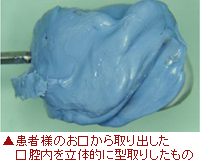 First we determine the height of the upper and lower teeth. Then we determine the position of the upper and lower jaw.
First we determine the height of the upper and lower teeth. Then we determine the position of the upper and lower jaw.
It takes about 5 minutes for the mold to harden, so we have you breathe slowly through your nose during this time. We collect very valuable information in the meantime.
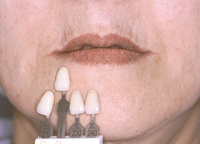 We also use this time to have you select your artificial teeth. Artificial teeth used in full dentures made through the maxillomandibular simultaneous impression method use a functionally and esthetically superior design by Dr. Strack. We discuss with the patient and take into consideration things like skin color and face outline when choosing the teeth.
We also use this time to have you select your artificial teeth. Artificial teeth used in full dentures made through the maxillomandibular simultaneous impression method use a functionally and esthetically superior design by Dr. Strack. We discuss with the patient and take into consideration things like skin color and face outline when choosing the teeth.
After we have measured precisely the state of the upper and lower jaw and have placed it in the actuator, we then line up the selected artificial teeth. We form the gums with wax.
The human jaw is extremely precise and a discrepancy of just a few millimeters can be felt. Because of this, we place the mold into a device that mimics the movements of the jaw (an actuator) in order to make sure that there is no awkward feeling in the mouth.

5. We conduct the pre-completion check
We will have you put in the wax dentures in order to conduct a pre-completion check.
+ Esthetic check ... check the shape and color of teeth, etc.
+ Fit check ... check to see that dentures fit right and do not jostle
+ Pronunciation check ... check to make sure you can pronounce words correctly
+ Bite alignment check ... check to see that you can bite firmly without difficulty
These are the types of things we check for.
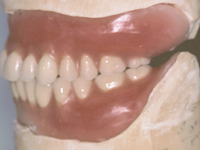 After this we replace the wax dentures with ones made of long-lasting hard materials (synthetic resin and metal). The retention of the dentures will be completely different from when you had your teeth. There will be nothing but a foundation in your jaw.
After this we replace the wax dentures with ones made of long-lasting hard materials (synthetic resin and metal). The retention of the dentures will be completely different from when you had your teeth. There will be nothing but a foundation in your jaw.
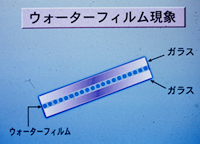 Full dentures use the water-film phenomenon (the same mechanism that causes 2 layers of glass to stick together firmly when a layer of water lays between them) to ensure that they will not fall out.
Full dentures use the water-film phenomenon (the same mechanism that causes 2 layers of glass to stick together firmly when a layer of water lays between them) to ensure that they will not fall out.
This is why we must make your dentures so that they match up perfectly with the contours of the shape of the gums in your jaw. This operation is called polymerization. After polymerization, the dentures are completed after they have been buffed and polished.

6. Final check [completion]

We put in your beautifully polished dentures. Then we make the final check for esthetics, fit, bite alignment, pronunciation, and retention force.
You will not be used to your new dentures immediately after you put them on for the first time so there may be slight awkwardness or pain. But dentures made correctly will certainly get better with slight adjustment.
With dentures that fit just right, you will be able to eat foods that have an elasticity to them, such as pickles, meat, squid, and octopus, without any worry of your dentures coming out. You will also be able to speak confidently without worrying. Moreover, our dentures barely ever cause discomfort so you can sleep with them in at night. It will be as if our full dentures are a part of your own body. Please enjoy the freedom you will gain from using them.
2009年4月15日
An advanced [Telescope] case treated with Riegel telescope restores a patient's ability to bite
[Riegel telescope case]
A patient came to us wearing dentures with magnetic clasps saying, "I can't bite into things..." The strength of the magnetic clasps was such that the dentures could be removed by hand. It is no wonder that they came loose easily when chewing food.
Riegel telescope dentures use a small locking mechanism placed on their inner side. The dentures can be put on and taken off by opening and closing this lock. There is never any risk of them slipping off while eating.
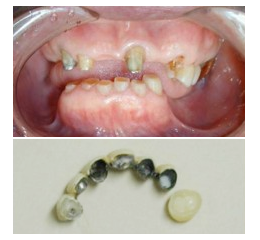 This case was extremely complicated. The patient only had front teeth left on the upper jaw and was using a simple set of dentures. The problem was the bottom teeth. The bottom front teeth were greatly worn down and as for the back teeth, the bones had completely absorbed the dentures.
This case was extremely complicated. The patient only had front teeth left on the upper jaw and was using a simple set of dentures. The problem was the bottom teeth. The bottom front teeth were greatly worn down and as for the back teeth, the bones had completely absorbed the dentures.
The patient came to our clinic extremely troubled because they were not able to eat and their dentures easily broke.

First, we reinforced and repaired the patient's usable teeth. Since the patient's bite alignment plane was also off, we aligned it to achieve bilateral symmetry. This is where we put false teeth into the upper jaw. At this point, the patient was overjoyed to regain the ability to bite.
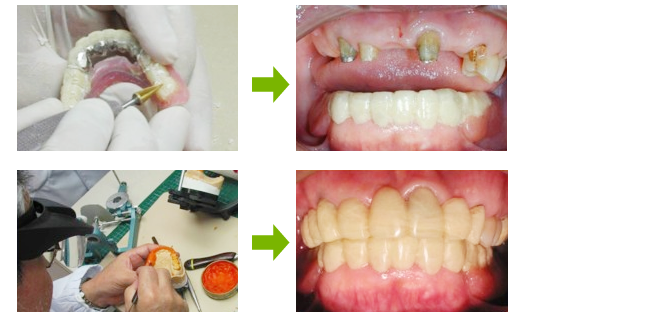
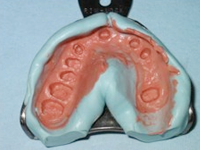 After making a wax mold and examining it, we decided to use Riegel telescope to fix the condition of the upper and lower teeth. The pictures below are of precision molds we had taken.
After making a wax mold and examining it, we decided to use Riegel telescope to fix the condition of the upper and lower teeth. The pictures below are of precision molds we had taken.

The finished upper and lower Riegel telescope dentures.


The picture on the left shows the lock (Riegel lever) in the closed position while the picture on the right shows it in the opened position.
The lock can be easily opened and closed using a finger, and when it is closed it is unnoticeable to the tongue. It helps to think of it as a kind of removable bridge.
Since the prosthetic teeth are ceramic, the final product is esthetically beautiful. The metallic parts are completely hidden when the dentures are set in place inside the mouth.
*Cases introduced on the website are completely unique to the patients and actual treatment periods and methods vary for each patient.
A case concerning severe gingivitis and dentures
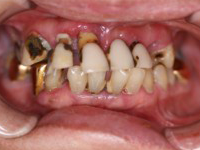 This patient came to our clinic suffering from gingivitis and bad breath. The patient shared that they were aware of how bad their situation was and decided to visit us to take care of the problem once and for all.
This patient came to our clinic suffering from gingivitis and bad breath. The patient shared that they were aware of how bad their situation was and decided to visit us to take care of the problem once and for all.

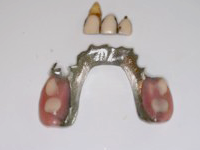 Unfortunately, the patient's front teeth were loose and there was nothing we could do to preserve them. In this case we had to extract the loose teeth.
Unfortunately, the patient's front teeth were loose and there was nothing we could do to preserve them. In this case we had to extract the loose teeth.

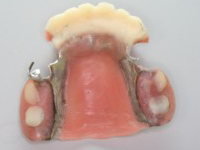 Before we extracted the patient's teeth, we altered the dentures so that they wouldn't have to go around with no front teeth after the extraction. We made false teeth for the front ones and reinforced the upper jaw so that the patient could bite again.
Before we extracted the patient's teeth, we altered the dentures so that they wouldn't have to go around with no front teeth after the extraction. We made false teeth for the front ones and reinforced the upper jaw so that the patient could bite again.
Normally when teeth are extracted it is necessary to leave the area open for a while which can hinder the patient's lifestyle. In order to spare the patient from this negative experience, we establish a treatment plan in advance.

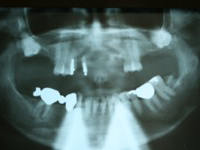 We extracted 2 teeth from the upper jaw and used 4 others to support Resilience telescope dentures. There were more teeth left in the lower jaw but since many of them were loose due to pyorrhea, we chose the Riegel telescope method which would secure and link them together.
We extracted 2 teeth from the upper jaw and used 4 others to support Resilience telescope dentures. There were more teeth left in the lower jaw but since many of them were loose due to pyorrhea, we chose the Riegel telescope method which would secure and link them together.

We attached inner crowns to the upper jaw and used them to snap the Resilience telescope dentures into place.


We secured the loose teeth of the lower jaw by linking them with an inner crown, which was further secured with the Riegel telescope dentures that fit over them.


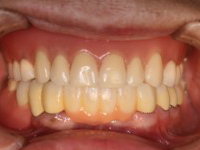 This is when we set the dentures in place in the patient's mouth. Only white is visible making these dentures undetectable to other people.
This is when we set the dentures in place in the patient's mouth. Only white is visible making these dentures undetectable to other people.

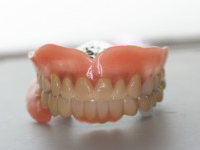
The patient was very pleased after putting the dentures on and shared with us that they wanted to hurry up and go out to talk and smile with new people. This was significant as the patient had had a complex about talking and smiling before they came in.
We are always very pleased to see this patient's beautiful smile each time they come in for maintenance.
*Cases introduced on the website are completely unique to the patients and actual treatment periods and methods vary for each patient.
2009年4月14日
Keep your dentures and remaining teeth for a long time through periodic maintenance
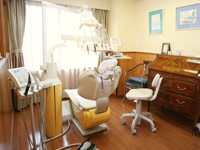 Maintain the health of your teeth and continue to use your dentures and your remaining teeth for a long time through maintenance. In order to be able to use your dentures as long as possible, prevention is the key. Of course it is important to brush your teeth every day, but we also recommend that you come in to the clinic periodically for tooth cleaning.
Maintain the health of your teeth and continue to use your dentures and your remaining teeth for a long time through maintenance. In order to be able to use your dentures as long as possible, prevention is the key. Of course it is important to brush your teeth every day, but we also recommend that you come in to the clinic periodically for tooth cleaning.
Remove stains impervious to regular brushing with our supersonic scaler
Tooth cleaning carried out by dentists or dental hygienists is carried out using a special device that removes stains called a supersonic scaler. This is especially useful on plaque caused from the attaching of calcium in saliva to plaque that is impossible to remove through regular means such as brushing.
Even if there are no specific problems, you can prevent cavities and pyorrhea by having your teeth cleaned periodically by a dentist or a dental hygienist. This will also make you more concerned with your teeth and raise your awareness of your own oral condition. This results in positive effects on dental health.
On the other end of the spectrum, there is a very high risk that people who are never examined by a dentist are late in discovering major abnormalities in their mouth, and when they finally are aware of their gingivitis (pyorrhea), it is too late.
In the case of dentures, some people don't think that it is necessary to get maintenance if they can bite comfortably. But, when dirt builds up, this can lead to bad breath, and it doesn't look very nice either. Especially in the case of partial dentures, without proper maintenance, the teeth acting as a support for the dentures can develop gingivitis and fall out.
Riegel telescope dentures from Inaba Dental Office can be adjusted should the patient lose teeth, but in the case of regular dentures covered by health insurance, dentures need to be remade each time a tooth falls out. Because of this, periodic maintenance is very important in order to prevent the loss of even just one tooth.
So would you rather play it safe and come in for maintenance and keep your dentures for a long time? Or do you prefer to continue to lose your teeth and have new dentures made each time?
In order to protect your important teeth and use your teeth comfortably, we suggest coming in for maintenance once every 3 months (periodic checkup).
*Maintenance cost is 12,000 yen each time.
Here is an explanation of the maintenance procedure
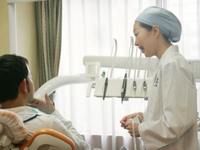 1. First we ask the patient about the condition of their mouth.
1. First we ask the patient about the condition of their mouth.

2. Next we check each tooth individually for cavities using a magnifying glass. It is particularly easy for cavities to develop in the spaces between teeth, so we also check to make sure you are flossing.

3. We then use a supersonic device to remove plaque from the surface of the teeth. The dental hygienist will use an item called a scaler to neatly remove plaque from deep pockets between the teeth and gums.

4. We then clean discoloration from the teeth and then finish them off with a machine brush.

5. We then massage the gums by going over all teeth with an interdental brush.

6. Finally the dental hygienist provides advice on how to brush properly, and if you wish we also apply fluoride.
For dentures, we perform supersonic cleaning, brush clean any teeth that are discolored, and then check to make sure that nothing is broken. Our Riegel telescope dentures should last a lifetime with proper maintenance.
Also, remember that your own teeth are assets that help you lead a fulfilling life. No matter how high the level of technology, artificial teeth can never compare to natural ones. We are happy to do whatever we can to in order to protect your remaining teeth.
2009年4月13日
[Full dentures] are loose and the patient can't bite. They experience pain when moving their mouth
[First visit]
The patient came to our clinic stating the following reasons:
+ "My dentures are so loose that I cannot bite. It hurts every time they move..."
+ "It is a bother to talk in front of people".
The patient told us that they had an inferiority complex about their teeth.
![[Full dentures]](/images/case015.png)
They wanted us to help alleviate the pain so they could enjoy eating and get over their inferiority complex. We decided to treat with full dentures made using the maxillomandibular simultaneous impression method to address the patient's pressing concerns.
[Taking the first mold impression]
Comparing the dentures that the patient came in with to their teeth mold, we found out that the dentures where smaller than the space in the patient's mouth and were nearly completely lacking support from the mouth muscles.
![[Full dentures]](/images/case016.png)
![[Full dentures]](/images/case017.png)
We made a tool based on this model to create a precise mold.

[Second visit to the clinic]
![[Full dentures]](/images/case018.png) The picture below is of the Gothic arch. It is used to record the movements of the jaw. In this case the jaw movements were normal.
The picture below is of the Gothic arch. It is used to record the movements of the jaw. In this case the jaw movements were normal.

Using the upper tray, we take a precise mold of the upper and lower jaw. At this time we are simultaneously recording the position of the jaw in regards to the central point of the body, and measuring the height of the bite alignment.
As the mold is being taken, we have the patient swallow their saliva in order to recreate the state of the mouth muscles while eating.
![[Full dentures]](/images/case019.png)
![[Full dentures]](/images/case020.png) After taking the mold, we choose artificial teeth that match the patient's skin color and facial features.
After taking the mold, we choose artificial teeth that match the patient's skin color and facial features.

![[Full dentures]](/images/case021.png) We transfer the myriad data to a bite alignment device called an actuator. Then we make the dentures using this model.
We transfer the myriad data to a bite alignment device called an actuator. Then we make the dentures using this model.

We create a shape using wax before the dentures are complete, line up the artificial teeth and then check everything. This is when we make detailed checks for things like pronunciation, comfort, and esthetic beauty.
![[Full dentures]](/images/case022.png)

![[Full dentures]](/images/case023.png) We conduct polymerization using the Ivocup-System. This transforms the wax into a hard material.
We conduct polymerization using the Ivocup-System. This transforms the wax into a hard material.

This is when the completed dentures were first placed into the patient's mouth. We insert a bite alignment lead called a 'full-balanced occlusion'. The information put into the actuator matched up perfectly with the conditions inside of the patient's mouth.
![[Full dentures]](/images/case024.png)
We made a few final adjustments after putting the dentures in and the patient is now able to enjoy them as if they were a part of his own body. The patient was also very pleased that pronunciation improved dramatically thanks to the dentures.
*Cases introduced on the website are completely unique to the patients and actual treatment periods and methods vary for each patient.
My body is in no condition to go through implant surgery...
Q. My body is in no condition to go through implant surgery...
A. This is not a problem. There is no need for surgery as with implants.
We can treat your case within the scope of normal dental treatment. We can adapt to the needs of patients who were told that implants are too difficult, elderly patients, and patients who suffer from a range of systemic diseases.
I would like to get implants, but it is too expensive because I need so many.
Q. I would like to get implants, but it is too expensive because I need so many.
A. In this situation we recommend that you use the telescope system.
Dentures made using the telescope system link together and fix remaining teeth in place. These dentures are superior functionally and esthetically and they help prevent further tooth loss. They feel like your own teeth and no one can tell that you are wearing dentures.
If you only have a few teeth remaining, the telescope system is almost always more economical than getting implants.
I'm in my 40s. Should I just get implants?
A. If your remaining teeth are strong and you are only missing a few of them, then implants may be the right choice for you. If you only have a few remaining teeth and you require many implants, it would be cheaper and more effective to choose the telescope system.
If you are only missing a few teeth but you suffer from advanced pyorrhea or many of your teeth are missing nerves, it is reasonable to assume that you will lose more teeth and therefore it would be better to choose the telescope system for treatment.
This is because the telescope system links together and firmly fixes teeth in place helping to prevent further tooth loss. Even if you happen to lose more teeth, your dentures can continue to be used with only minor adjustments.
How many years do dentures last?
Q. How many years do dentures last?
A. Telescope system dentures have a very long history. Some dentures made in Japan 31 years ago, when the technology was first used in Japan, are still in use today.
When we administer treatment using dentures (telescope system), we spend a lot of time designing them with the patient's condition in mind so that they can be used for a long time. Because of this, our dentures can be used for a very long time and many of our patients tell us that they have become a part of their bodies.
What should I do if my dentures break?
Q. What should I do in case my dentures break?
A. In the same way that earthenware that is dropped and then repaired is liable to break again in the same spot, our dentures can also be repaired. However, we ask that you take very good care of them since they may lose some structural integrity
One feature of telescope system dentures is that they can be taken off, even after breaking, and repaired. Even still, we ask that you please take very good care of them.
Is it necessary to use denture adhesives?
Q. Is it necessary to use denture adhesives?
A. There is no need to use denture adhesives.
The membrane portion that uses denture adhesives, and the method used to make the gums (polymerization) are completely different from dentures covered by insurance. Our dentures are made using the Ivocup System, which allows them to make use of the water-film phenomenon (this is the same phenomenon that causes two panes of glass to stick firmly together when a layer of water lays between them). The retention created by this phenomenon is so great that there is no space left between the dentures and the mouth to use denture adhesives.
Should I take out my dentures before going to bed?
Q. Should I take out my dentures before going to bed?
A. With full dentures and partial dentures, we recommend that you take them out to brush them clean, put them back in, and then rest with them in. According to a survey of full denture wearers from Japan and Germany, many Germans sleep with their dentures in while many Japanese take them out. It seems that many people are afraid to be seen by their family members without their dentures.
There were many people who lost their dentures during the Great Hanshin Earthquake because they took them out at night. If you clean your dentures well at night, then you can sleep with them in.
Is it true that it is difficult to speak clearly with dentures in?
Q. Is it true that it is difficult to speak clearly with dentures in?
A. When the top portion of full dentures is thick, this can impede the movement of the tongue and make it difficult to clearly pronounce words. When the lower portion of full dentures extends back behind the tongue, this can also impede the movement of the tongue and make pronunciation difficult in the same way.
Telescope system full dentures that use the maxillomandibular simultaneous impression method are made upon careful examination so as to make pronunciation easy. We even have patients who can pronounce English without any problems with their dentures in.
I heard that it becomes harder to taste food...
Q. I heard that it becomes harder to taste food...
A. Loss of the ability to taste food is a comprehensive problem. The tongue can taste sweet, spicy, salty/spicy, sour, bitter, and many other flavors. The ability for your membrane to detect the warmth or coolness of food dullens as the membrane gets thicker.
Foods like squid and natto that have a gooey texture easily stick to dentures making them more difficult to taste. With these factors it is true that some foods become harder to taste when wearing dentures.
Dentures made using the maxillomandibular simultaneous impression method are made to be 1.5 millimeters thick. Also, the membrane portion of the dentures can be made with metal with a thickness of 0.5 millimeters. With our ultra-thin dentures it is easier to detect warmth and easier to enjoy flavors.
Is there any chance that my dentures will just suddenly come off?
Q. Is there any chance that my dentures will just suddenly come off?
A. Since Riegel telescope dentures use a small locking mechanism, there is no risk of the latch spontaneously coming undone and your dentures falling out.
Can people see the metal on my partial dentures?
Q. Can people see the metal on my partial dentures?
A. Partial dentures covered by insurance use metal springs called clasps that are visible to people around you. Telescope system dentures use nothing of the sort meaning that metal is not visible even when you laugh.
I can't eat anything hard. Is there anything I can do to fix this?
Q. I can't eat anything hard. Is there anything I can do to fix this?
A. If your dentures move around inside your mouth then it will be very difficult to make a clean bite through hard food. Dentures made at Inaba Dental Office do not move inside the mouth so you can enjoy even the hardest of foods with no problems.
The artificial teeth in our dentures are Strack design. They are made using the latest research and development in the field of artificial tooth shape and with much consideration given to jaw movements. These teeth are made with much attention given to the anatomical shape of natural teeth and they feature natural groves that aid in the chewing of food.
What kinds of foods will I be able to eat?
Q. What kinds of foods will I be able to eat?
A. One patient who was treated at Inaba Dental Office with the telescope system likes to tell us what she has been able to eat each time she comes in. So just the other day, we asked her, "If you don't mind, could you please make a list of what kinds of foods you are now able to eat?" This is how she responded*
☆ 彡:・;.*:・。゜゜・:゜*:。゜.*。゜.o。・。゜。o.゜。・*。・゜.。☆彡
*Sushi rolls and regular sushi
I can bite into them, chew them good, and swallow. When I had inlays, I was unable to pull with my teeth so I had to dissect the larger sushi rolls and have the smaller ones cut into 1 cm pieces. Kampyo rolls were especially difficult. The kampyo and the seaweed would just get flattened out and I would have to swallow it like that or break the rules of manners and pull it apart. I love sushi and having the chef roll them fresh in front of me at the counter is one of my joys in life. It was tough before always having to consult with my teeth on what types of sushi I could eat, especially squids and clams were particularly hard to bite. I haven't tried abalone yet but I can firmly bite into ark shell clams, cockles, and mirugai clams.
*Oranges and other citrus fruits
I can bite into orange wedges and chew the pulp in my mouth now without any problems. When I visit a friend's house or go out to eat, I often encounter orange wedges or other citrus fruit wedges... I've always wanted to eat them but I felt like it wouldn't be a good idea with dentures. At home I used to peel and eat citrus fruit by the bushel. My husband and daughter had to eat the same way... It was kind of a side-effect of my condition.
*Uncooked vegetables
I used to get so worried when someone would take out a raw radish, unpeeled and cut into eighths. Now I am so grateful that I can bite into these easily now. I can now eat cucumbers, takuan, and kinpira, without hesitation.
*Pie
I now can eat flaky pie crust with no problems. Pie crust used to be quite high level for me but since I like it so much, I used to cut it into small pieces to eat. It was far from beautiful eating form so I only ate pie alone at home in secret.
I am so happy that I can now eat many different things. And I am even happier that I do not need to cover my mouth every time I speak. That truly is the greatest joy. You have always been so polite when treating me and always have a smile on your face. I was able to go through the treatment process without feeling any apprehension. I am always grateful. You helped me overcome a complex that I have had for a long time. If I notice anything else, I'll gladly let you know.
The patient who shared the above message with us came in for tooth cleaning with her husband the other day.
Of course she regained the ability to eat. She also had her bite evened on the left and right side of her jaws. This creates a nice muscular balance and leads to a wonderful full face.
This type of feedback always brings us a lot of joy.
Thank you very much.
What is the locking mechanism on Riegel telescope dentures?
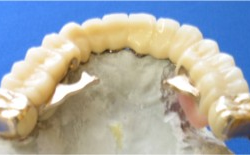 Riegel telescope dentures use a dual covering method for the teeth. After you set them and fix them in place, you can remove them by using the integrated small locking mechanism.
Riegel telescope dentures use a dual covering method for the teeth. After you set them and fix them in place, you can remove them by using the integrated small locking mechanism.
Remove the dentures by opening the lock. When you close the lock, the device cannot be felt by the tongue so there is no uncomfortable feeling.
There are two different locking mechanisms according to the condition of the patients remaining teeth. They are called Schwenk Riegel, and Dray Riegel. There are other locking mechanisms that I have actually seen in Germany, but these two are superior.
Are there false teeth I can use while waiting for my dentures?
Q. Will you provide me with false teeth while I wait for my dentures?
A. Of course we will make you false teeth.
Be relieved to know that we will make sure that no one can tell that you are undergoing treatment.
We receive many questions from patients worrying about going around with missing teeth while their dentures are being made. We take various measures to make sure that no one can tell that our patients are undergoing treatment.
It would be impossible to eat and communicate without your teeth during treatment. This can cause your family to worry as well.
At our clinic, we absolutely provide false teeth for our patients while they wait for dentures.
Before having your teeth removed, we make a set of false teeth based on an assumption of the condition of your mouth post-extraction. It is very important to us to consider the esthetic and functional recovery of our patients' oral condition after extraction
We also provide support throughout treatment to help our patients feel at ease and get used to false teeth. I don't think that you need to worry about any negative effects at work.
By making you a set of false teeth, you can continue to eat healthily even while undergoing treatment.
The telescope system requires an extremely high level of precision which means that even the slightest change of tooth position can throw the process off. False teeth are extremely important because they help prevent teeth from moving.
My gums have become thin. Can I still get dentures?
A. Yes, you can. It is generally difficult to have implants put in with thin gums. And it is also considered a difficult case even with full dentures. But full dentures that make use of the muscles around the mouth, even for patients with thin gums, can be made using the maxillomandibular simultaneous impression method. Even with thin gums, these dentures adhere firmly and will not come out (this is because they can make use of the water-film phenomenon).
*Water-film
This is the phenomenon when two plies of wet glass adhere firmly when placed on top of one another.
How long is the treatment period?
The telescope system offered at our clinic involves a very complicated manufacturing process and the technical work requires time. The situation differs case by case, but it usually requires 4 visits starting with the first one where a mold of your jaw is taken.
The process proceeds according to plan and even when the dental technician is completely focused on one project, it can take from 3 - 4 weeks before we are ready to have you come in for the next step.
It is different in each case, but it typically takes 3 - 4 months from taking the first mold to receiving your dentures.
(Full dentures are done completely through appointment and there is a course that can be completed in 3 days.)
Also, in the unfortunate case that you absolutely must have teeth extracted, we ask that you wait six months before having a mold taken so that your bone has a chance to stabilize. In the meantime, we provide false teeth and support so that you can freely continue your daily activities without drawing attention to your oral condition.
Do I need to have teeth extracted to get dentures made?
Q. Do I need to have teeth extracted to get dentures made?
A. There is no need to have teeth extracted unless you have an advanced case of pyorrhea and your teeth are loose.
Slightly loose teeth can be fixed into place with dentures.
We try to make the most use of teeth that look like they may need extraction in the future. And even if we have to extract those teeth, you can still use your same dentures with only slight adjustments.
2009年4月12日
Might you have TMJ arthrosis?
Do you suffer from any of the following symptoms?
+ Do you clench or grind your teeth?
+ Do you feel pain or stiffness in your jaw?
+ Do you often get headaches or pain in the neck? And is it worse when clenching?
+ Does the pain when clenching get worse when you feel stressed?
+ Does your mouth pop or creak when you open it? Is it difficult to open your mouth?
+ Do you have any other types of arthrosis or problems in your joints?
+ Is it difficult to clench your teeth for a long time?
+ Does your bite alignment change from time to time?
+ Is it difficult to clench or tear food with your front teeth?
+ Are your teeth sensitive? Do they move, crack, or are they worn down?
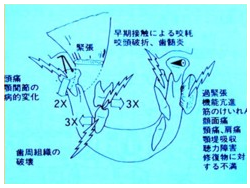 If you are suffering from any number of the symptoms listed above, it is likely that you may have TMJ arthrosis. Since there are many causes of TMJ arthrosis, it is almost always very difficult to know whether or not the jaw is the source of the problem.
If you are suffering from any number of the symptoms listed above, it is likely that you may have TMJ arthrosis. Since there are many causes of TMJ arthrosis, it is almost always very difficult to know whether or not the jaw is the source of the problem.
Symptoms of TMJ arthrosis
☑tooth wear
☑nerve pain from tooth wear (sting when touching hot or cold)
☑inflamed gums ☑root pain ☑grinding
☑pain in jaw joints ☑pressure pain in jaw joints ☑neck or head pain
☑ringing in the ears ☑difficulty hearing ☑loss of sensation in hands or feet
☑uneven posture (unable to keep balance)
TMJ arthrosis treatment varies according to the symptoms.
Treatment begins with a detailed search for the causes.
All Examination Rooms Are Private Rooms
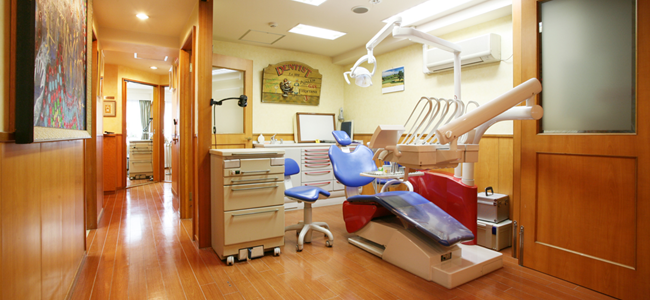
We have 3 fully private examination rooms prepared for our patients. They are interior decorated to make our patients feel at home, complete with pictures and antique furniture.

TMJ arthrosis caused by dentures
Some patients complain saying, "I cannot open my mouth wide", or "There is pain in the joints around my jaw". Upon further examination the number of middle-aged patients who complain of the following symptoms is increasing:
+ "I have stiff shoulders."
+ "My back aches."
+ "I have lost sensation in my arms and legs."
+ "There is ringing in my ears."
+ "I get terrible migraines."
These are all symptoms of TMJ arthrosis.
TMJ arthrosis is a condition in which the area around the jaw hurts, opening the mouth becomes difficult, and a clicking or scraping noise can be heard coming from the jawline area. TMJ arthrosis is considered an ailment common in people in their 20s and 30s due to bad tooth alignment, or an unbalanced bite caused by wisdom teeth.
However, cases of TMJ arthrosis in middle-aged patients are mostly attributed to poor bite alignment due to silver crowns and especially dentures.
If you wear dentures and suffer from any of the symptoms listed above, please contact us for consultation. We can fix your bite alignment and help alleviate your discomfort.


